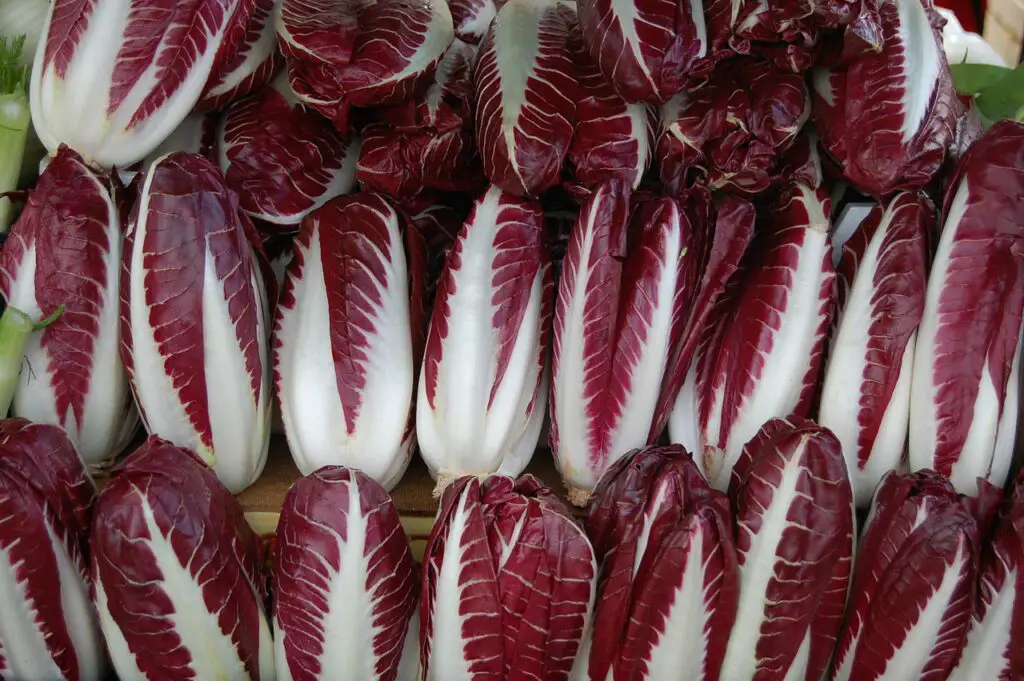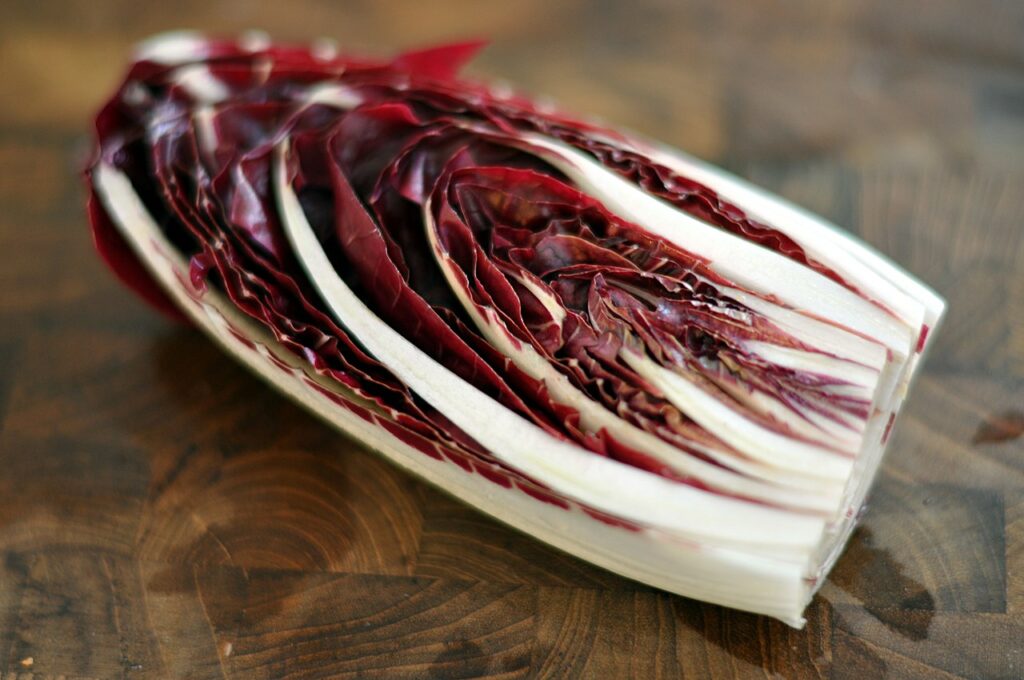Are you a proud dog owner who is curious about what human foods are safe for your furry friend to eat? If so, you might be wondering if your dog can eat radicchio.
This red-tinged vegetable, also known as Italian chicory, is a popular ingredient in salads and other dishes.
But before you share a bite with your pup, it’s important to know whether radicchio is safe for dogs to consume.
In this article, we’ll explore the nutritional benefits and potential risks of feeding radicchio to dogs.
- Can Dogs Eat Radicchio?
- How Much Radicchio Can Dogs Eat?
- How Often Can Dogs Eat Radicchio
- Health Benefits of Radicchio To Dogs
- Potential Risks of Feeding Radicchio To Dogs
- Nutritional Benefits of Radicchio For Dogs
- Are Dogs Sensitive To Radicchio?
- How To Prepare Radicchio For Dogs
- How Fast Will Dogs Digest Radicchio
- In Conclusion
Can Dogs Eat Radicchio?

Yes, dogs can eat radicchio in moderation. Radicchio is a type of cultivated chicory that is low in fat and a good source of vitamins and minerals. It also contains dietary fiber which can help to keep your pup’s digestive system healthy.
However, it should only be given as an occasional treat, as too much radicchio can lead to bloating or other digestive issues.
When feeding your dog radicchio, make sure to chop it into small pieces so they don’t choke on it.
Additionally, you should always check with your vet before introducing any new foods into your pup’s diet.
Overall, radicchio is safe for dogs to eat in moderation and can provide them with some important nutrients.
Just remember to feed it in small amounts and consult with your vet if you have any questions or concerns about adding it to their diet.
See also: 47 Safe Vegetables To Feed Your Dog. Puppy Power!
How Much Radicchio Can Dogs Eat?

As a general guideline, fruits and vegetables should only make up about 10% of your dog’s diet. This means that while radicchio is safe for dogs to eat, it should be given in small amounts as an occasional treat.
A good rule of thumb is to give your pup a few small pieces of radicchio (chopped into bite-sized pieces) and observe how they react. Keep in mind that too much radicchio can cause digestive issues such as bloating, gas, or diarrhea.
If you’re unsure if radicchio is a good fit for your dog’s diet, talk to your veterinarian. They can help you determine the appropriate amount and frequency of radicchio treats based on your pup’s individual health needs.
Radicchio Feeding Chart According To Size
| Food | Size | Portion |
|---|---|---|
| Radicchio | Toy dogs | 2-3 bite-size pieces |
| Radicchio | Small dogs | 2-3 bite size pieces |
| Radicchio | Medium dogs | 3-4 bite-size pieces |
| Radicchio | Large Dogs | 4-5 bite size pieces |
Radicchio Feeding Chart According To Age
| Food | Age | Portion |
|---|---|---|
| Radicchio | 0 – 6 months | Don’t feed |
| Radicchio | 6 – 12 months | 2-3 bite-size pieces |
| Radicchio | 12 – 24 months | 3-4 bite-size pieces |
| Radicchio | 24+ months | 4-5 bite-size pieces |
How Often Can Dogs Eat Radicchio
The frequency with which you can give your dog radicchio will depend on their individual health needs, dietary requirements, and tolerance to the vegetable.
As a general rule, it’s best to offer small amounts of radicchio once or twice per week, rather than as a regular part of their diet.
Radicchio can be a healthy addition to your dog’s diet when given in moderation. However, as with any new food, it’s important to introduce radicchio slowly and in small amounts to make sure it agrees with your pup’s digestive system.
Health Benefits of Radicchio To Dogs
Rich in Fiber
Radicchio is an excellent source of fiber, which is important for maintaining healthy digestion in dogs. Dietary fiber can help to promote regular bowel movements and prevent constipation.
Low in Calories
Radicchio is a low-calorie vegetable, which means that it can be a great option for dogs who are watching their weight. It is also a good alternative to higher-calorie treats like dog biscuits.
Contains Vitamins and Minerals
Radicchio contains a variety of essential vitamins and minerals, including vitamin K, vitamin C, folate, and potassium. These nutrients are important for supporting many of the body’s functions, from the immune system to bone health.
Promotes Healthy Vision
Radicchio is rich in antioxidants, which can help to protect the eyes from damage caused by environmental toxins and aging. It also contains the carotenoid lutein, which has been shown to promote healthy vision in dogs.
Boosts Immune System
The vitamins and minerals found in radicchio can help to support a healthy immune system in dogs. This can help to reduce the risk of infections and illnesses by controlling inflammation and oxidative stress.
Potential Risks of Feeding Radicchio To Dogs
Gastrointestinal Issues
Radicchio, like other vegetables, can be difficult for dogs to digest in large quantities, leading to gastrointestinal issues such as vomiting, diarrhea, or bloating.
High Levels of Oxalates
Radicchio, like other leafy green vegetables, contains high levels of oxalates that can bind together with calcium and create crystals in the urinary tract. This can lead to health issues such as urinary tract infections, bladder infections, or even kidney stones.
Choking Hazard
Due to its crisp texture, radicchio can pose a choking hazard to dogs, especially when fed in large pieces.
Allergic Reactions
Some dogs may be allergic to radicchio, which can cause symptoms like itching, swelling, hives, or digestive problems.
Pesticides
Radicchio may contain residues of pesticides that can be harmful to dogs. It’s important to wash radicchio thoroughly before feeding it to your pup or choose organic varieties when possible.
Nutritional Benefits of Radicchio For Dogs
| Radicchio Nutrition Facts per 100 grams | % DV * |
|---|---|
| Calories | 9 |
| Total Fat | 0 g |
| Cholesterol | 0 mg |
| Sugar | 0 g |
| Glycemic Index | 15 |
| Sodium | 9 mg |
| Carbs | 2 g |
| Protein | 1 g |
| Vitamin D | 0% |
| Calcium | 1% |
| Iron | 0% |
| Potassium | 0 mg |
Are Dogs Sensitive To Radicchio?
Yes, some dogs may be sensitive or allergic to radicchio. The symptoms of radicchio sensitivity in dogs may include:
- Itching and scratching Dogs who are allergic to radicchio may scratch and itch at their skin, sometimes excessively.
- Digestive Issues. Some dogs may experience gastric distress, such as vomiting or diarrhea, after consuming radicchio.
- Swelling In rare cases, dogs may experience swelling, particularly around the face, following ingestion of radicchio.
- Hives. Hives are raised, itchy bumps that can appear on a dog’s skin in response to an allergen like radicchio.
- Respiratory symptoms. In severe cases, some dogs may experience respiratory distress, such as difficulty breathing, wheezing, or coughing.
It’s important to note that not all dogs will be sensitive to radicchio, and these symptoms may also be caused by other underlying conditions. If you notice any signs of an allergic reaction or sensitivity after feeding your dog Radicchio, contact your veterinarian for advice.
How To Prepare Radicchio For Dogs
Chopped into bite-sized pieces
Radicchio can be chopped into small, bite-sized pieces and added to your dog’s meal as a healthy treat. Make sure to rinse the radicchio thoroughly before serving, and remove any tough stems. Chopping the radicchio into small pieces can also help prevent choking hazards.
Shredded into meals
You can also shred radicchio and add it to your dog’s regular meals. This can help boost the nutritional content of their meal and add some variety to their diet. Just make sure not to add too much, as too large a quantity can cause gastrointestinal distress.
Mixed with other dog-friendly vegetables
Radicchio can be mixed with other dog-friendly vegetables, such as carrots or green beans, to create a colorful and nutritious side dish. You can cook them together or serve them raw, depending on your dog’s preference.
How Fast Will Dogs Digest Radicchio
Every dog’s digestive system is different, and the speed at which they digest radicchio can depend on several factors, including their size, age, and overall health. However, as a general rule, dogs can digest radicchio fairly quickly, usually within 6-8 hours from ingestion.
Radicchio, like many other vegetables, is high in fiber, which can improve digestive health by regulating bowel movements and preventing constipation. However, too much fiber can cause diarrhea or other digestive upset.
In Conclusion
In conclusion, radicchio is a safe and healthy vegetable for dogs to eat in moderation.
It is a good source of fiber, vitamins, and minerals that can support your dog’s health and well-being when fed in the correct portion size.
However, it’s important to note that some dogs may be allergic or sensitive to radicchio, and too much can cause gastrointestinal issues such as diarrhea or bloating.





Leave a Reply